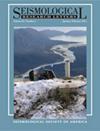Long-Term Infrasound Sensor Calibration and Characterization
IF 2.6
3区 地球科学
Q2 GEOCHEMISTRY & GEOPHYSICS
引用次数: 0
Abstract
Previous testing has shown that infrasound sensors deployed in the field can exhibit notable deviations from their nominal, lab-based calibrations. These variations may be due to changes in environmental conditions, long-term sensor drift, or other unresolved features. In early 2018, we installed two identical infrasound elements with five infrasound sensors at each element (Chaparral M50A, Chaparral M64LN, CEA/Martec MB2005, CEA/Seismowave MB3a, and Hyperion IFS-5113A). These sensors were accepted or under consideration for use in the International Monitoring System network of the Comprehensive Nuclear-Test-Ban Treaty. Each element had all sensors connected to a single digitizer and port to the atmosphere. We also recorded instrument enclosure air temperature and humidity and external air temperature. Using the MB2005 as the reference, we examine the relative sensor response (both magnitude and phase) as a function of time and frequency and compare it with quarterly laboratory calibrations and environmental conditions. We find that the magnitude response for all sensors exhibits some variability in both the lab and field, with the amplitude variations often >5%. The field-based variations are more severe and occur on both long-term (months) and short-term (hours) timescales. Short-term variability correlates with changes in environmental conditions and is considerable (up to 25%) for the Chaparral M50A and noticeable (∼5%) for the French Alternative Energies and Atomic Energy Commission (CEA) MB3a. Long-term magnitude variability for the Chaparral M50A was up to 50% and does not clearly correlate with environmental conditions. The other sensors show some long-term magnitude offsets, but they have relatively stable responses in the conditions we examined. The MB3a also displays some frequency-dependent magnitude variability and shows a minor dependence on temperature. Phase estimates are stable and near zero for all sensors tested. These results strongly suggest sensor response and variability due to environmental conditions should be considered in future infrasound data interpretation and sensor selection and development.长期次声传感器校准和特性分析
以往的测试表明,部署在现场的次声传感器可能会与实验室标定的额定值有明显偏差。这些偏差可能是由于环境条件变化、传感器长期漂移或其他未解决的特征造成的。2018 年初,我们安装了两个相同的次声元件,每个元件上有五个次声传感器(Chaparral M50A、Chaparral M64LN、CEA/Martec MB2005、CEA/Seismowave MB3a 和 Hyperion IFS-5113A)。这些传感器已被接受或正在考虑用于《全面禁止核试验条约》的国际监测系统网络。每个元件的所有传感器都连接到一个数字转换器和一个通向大气的端口。我们还记录了仪器外壳的空气温度和湿度以及外部空气温度。以 MB2005 为参照,我们检查了作为时间和频率函数的相对传感器响应(幅度和相位),并将其与季度实验室校准和环境条件进行了比较。我们发现,所有传感器的幅值响应在实验室和现场都表现出一定的变化,幅值变化通常大于 5%。基于现场的变化更为剧烈,并同时出现在长期(数月)和短期(数小时)时间尺度上。短期变化与环境条件的变化相关,Chaparral M50A 的短期变化相当大(达 25%),而法国替代能源和原子能委员会 (CEA) MB3a 的短期变化明显(∼5%)。Chaparral M50A 的长期幅度变异高达 50%,与环境条件没有明显关联。其他传感器显示出一些长期幅度偏移,但在我们检查的条件下,它们的响应相对稳定。MB3a 也显示出一些随频率变化的幅度偏差,并显示出对温度的轻微依赖性。所有测试的传感器的相位估计值都很稳定,接近零。这些结果有力地表明,在未来的次声数据解释、传感器选择和开发中,应考虑环境条件引起的传感器响应和变异。
本文章由计算机程序翻译,如有差异,请以英文原文为准。
求助全文
约1分钟内获得全文
求助全文
来源期刊

Seismological Research Letters
地学-地球化学与地球物理
CiteScore
6.60
自引率
12.10%
发文量
239
审稿时长
3 months
期刊介绍:
Information not localized
 求助内容:
求助内容: 应助结果提醒方式:
应助结果提醒方式:


